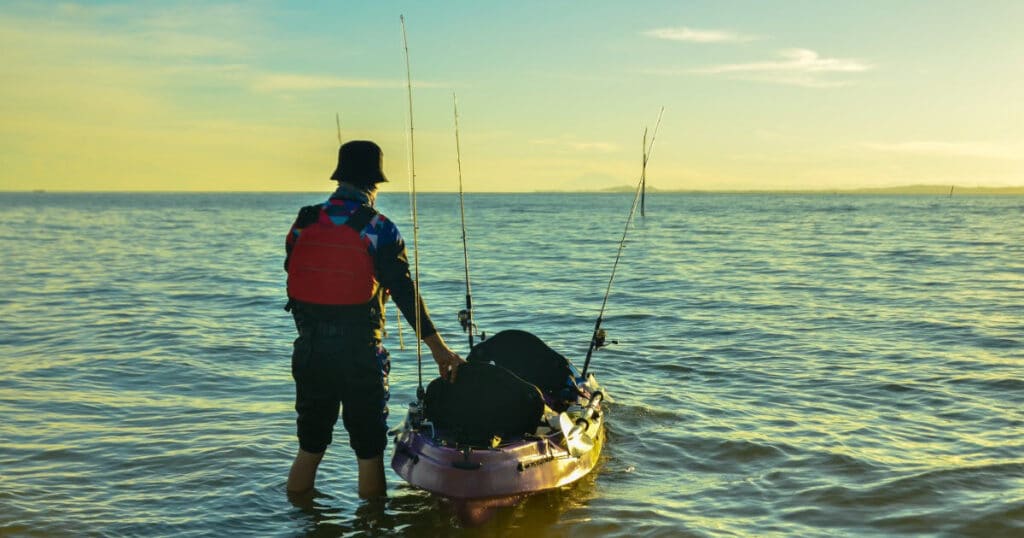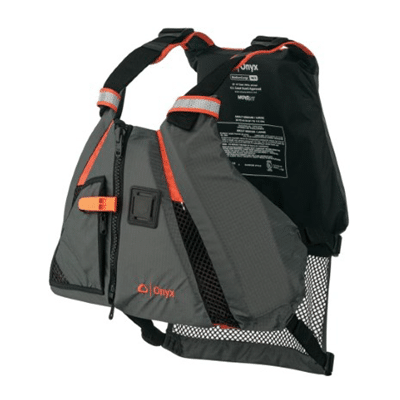Maybe you’re like me and have been angling for years. But even so, if you’ve never fished from a kayak, you probably don’t realize just how different of an experience that is. There are several things that you have to keep in mind to do it right. Specifically, there are many items you will need. Today I’m sharing my personal list of fishing kayak essentials – items I like to have on hand whenever I hop into my fishing kayak.
Kayak fishing is completely different from powerboat fishing. One of its most attractive features is how much more affordable it is! No need for fuel or motor maintenance. It’s also quiet, and more tactile than fishing from an elevated boat. You’re right up close with the water (and the fish).
So, let’s dive right into my list of kayak fishing essentials so you can gear up and get out there.
| PeacefulPaddle.com is reader supported. If you make a purchase after clicking a link, I may earn a commission at no additional cost to you. |
My List of Kayak Fishing Essentials
Your kayak needs to accommodate certain essentials for successful kayak fishing. I’ve grouped my full list of kayak fishing gear you will want to have on board into four categories:
And I go into full details and offer some of my favorite product recommendations in this article, but for reference, here’s a quick list of the kayak fishing essentials I recommend:
- PFD (personal floatation device
- First aid kit
- Whistle
- Food and water
- 360 visibility light
- Flag
- Paddle leash
- Tackle crate
- Rod holders
- Universal size paddle clip
- Fish grips
- Appropriate fishing rod
- Fishing paddle
- Anchor system
- Drift chute (or drift sock)
- Fish finder
- Kayak cart
- Adjustable clamp rod holder
- Dry bags
- Fishing pliers
- Hook removal tool
Now let’s get started with…
Safety Essentials
Remember all these items to stay safe on the water.
PFD (Personal Floatation Device)
When it comes to safety, your PFD (personal floatation device) is the most important of your fishing kayak essentials.
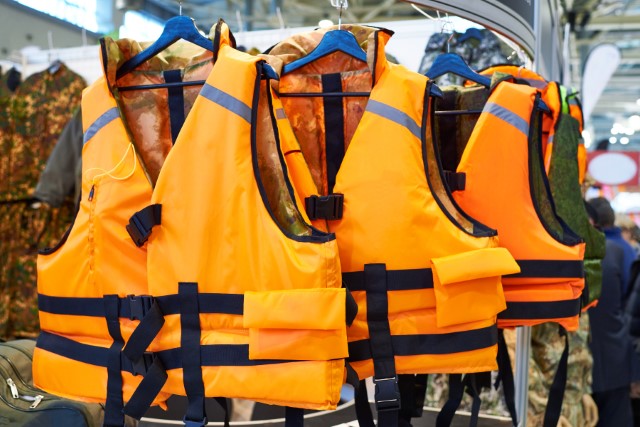
If you know watersports, you know PFDs (personal floatation devices), such as life jackets. Stay safe on the water as a kayak angler by wearing a life jacket at all times (a PFD may even be required in your state).
Find a life jacket specifically designed for kayak angling. This kind of PFD should have a plethora of pockets. You can keep tackle, pliers, and other fishing kayak essentials in them.
When deciding how many items to put in these pockets, however, you should think about your freedom of movement. If you pack the pockets too much, you might find it quite constricting.
Make sure that your PFD is adequately buoyant and has adjustable shoulder and side straps. It should also have D-rings.
No matter what PFD you get, make sure it fits properly. An ill-fitted life jacket won’t be effective and will give you a false sense of security. You should try on your PFD before you buy it.
Ask a professional to help you try on different life jackets and make sure you get one that fits you as it should. There are both inflatable and foam PFDs available that you could use for kayak fishing.
Foam-filled designs tend to be more reliable, as you don’t have to worry about reinflating them. However, they’re usually a bit heavier to wear.
First Aid Kit
This may seem like common sense, but it’s something that can easily be forgotten. A first-aid kit is essential for safety on a fishing trip.
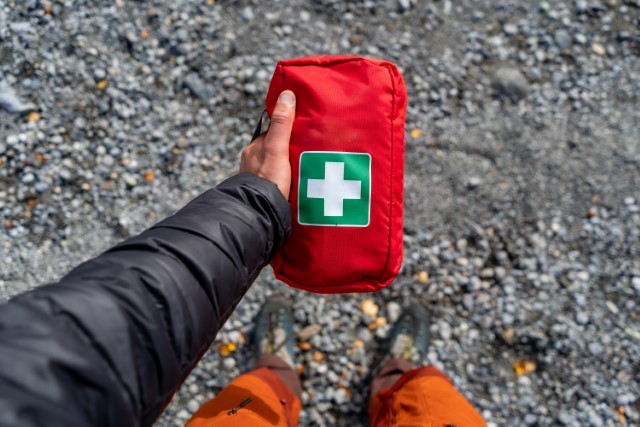
The best bet is to find a pre-made first aid kit for kayakers and other boaters. If you can’t find that kind of thing or want to put together a kit by yourself, there are certain things you should include.
Here are some examples:
- Antibiotic cream or ointment
- Bandages and band-aids
- Tweezers
- Headache and pain medication
- Electrical tape
- Cutters
- Sunscreen
- Gauze pads
- Pre-soaked iodine pads
- Splints
RECOMMENDED: Well-Strong Waterproof First Aid Kit
Whistle
Make sure you also have a whistle in case you need to make noise to call for help at any point.
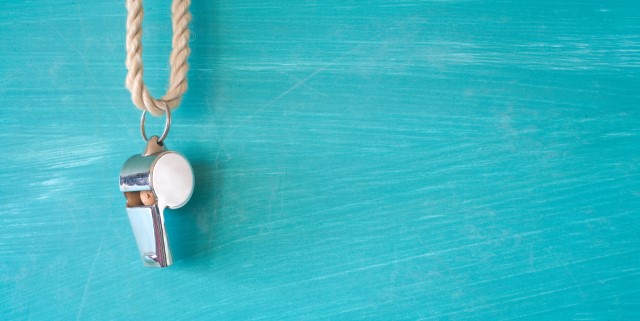
You should look for a whistle that is moisture resistant and loud (a bare minimum of 100 dB).
RECOMMENDED: Shoreline Marine Safety Whistle
Food and Water
Always have food and water with you when you go fishing.
Not bringing these supplies could potentially create a very dangerous or even deadly situation if things go wrong.
360° Visibility Light
You must have a 360° visibility light when you’ll be on the water after dark. Make sure to turn on the light before sunset, so that other vessels can see you and you’ll avoid collisions.
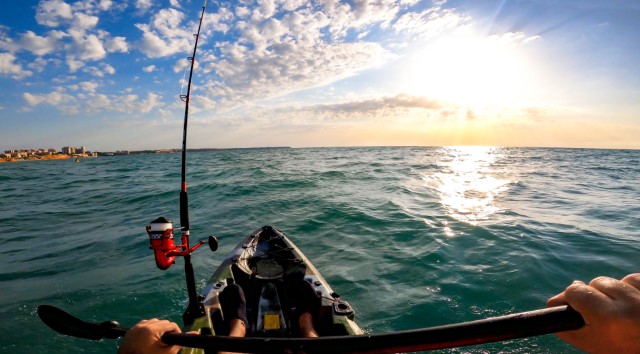
Of course, a light is also necessary for you to see clearly. Also, if there’s an emergency and you need help, rescuers can find you much more quickly.
Find a light that has a suction cup base or secure attachment. It should be a LED light.
RECOMMENDED: Propel Paddle Gear by Shoreline Marine Portable Safety Light
A Flag
By flag, I mean a safety flag. I always have a safety flag on my kayak, as it makes me more visible. And if you ever need help, rescuers will find you more quickly.
Do you angle in places where there are many other kayaks and other boats? A safety flag is an essential item in those circumstances.
Paddle Leash
A paddle leash will stop your paddle from floating away when you’re setting the hook. This means you’ll be able to focus better on what you need to do.
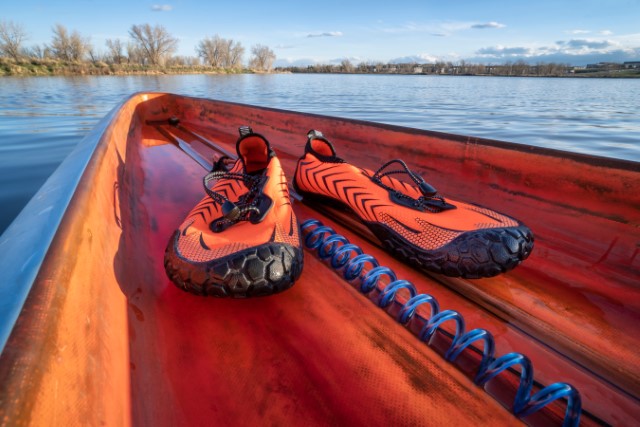
For kayak fishing, your paddle leash should be a minimum of 4 feet (or 1.2 meters) in length. It should be very durable.
RECOMMENDED: Oceanbroad Kayak Paddle Leash
Organization and Storage Essentials
Organization and keeping the right things at hand are crucial, too. Here are organization essentials for your kayaking fishing trip.
Tackle Box or Tackle Crate
A tackle crate will let you keep your tackle and rods well-organized and in a place you can always find them. It will also stop your equipment from moving all over the deck.
You can’t get serious about any kind of fishing, let alone kayak fishing, without keeping all your equipment and rods organized. While non-fishing anglers don’t have to carry as much stuff, angling kayakers need to have all the right gear.
Look for a tackle crate that includes a lot of organizational features, especially compartments in different sizes.
RECOMMENDED: Flambeau Outdoors 3000WPNC Waterproof Tackle Box with Trays
Rod Holders
Get rod holders that have all the features you need. While some models allow for quicker release (which can come in handy), other types will provide better security.
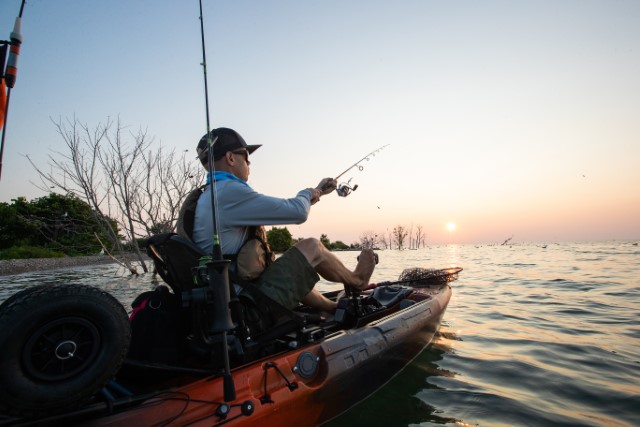
More than perhaps any other feature, rod holders are essential for fishing in a kayak. If you’re permanently installing the rod holders, think carefully when choosing the right places.
You don’t want to unnecessarily damage your kayak.
There’s a type of rod holder you can use if you don’t want to create any permanent changes. It’s called a deck mount rod holder. It’s simple and easy to mount on your kayak’s deck.
Another option is the flush mount rod holder. Many kayakers (including me) like this type of holder because of its more affordable price, and isn’t a permanent obstruction to your boat when not in use.
RECOMMENDED: Borogo 2-Pack – Kayak Deck Flush Mount Fishing Rod Holders
Universal Size Paddle Clip
Get a universal size paddle clip that is made from a durable material. Paddle clips are available in different designs, so you can choose one that best fits your needs.
Invest in a better quality one, avoiding anything too flimsy or cheap. After all, you don’t want to have to buy a new one after a few uses.
RECOMMENDED: Atader Kayak Track Mount Paddle Holder
Fish Grips
Fish grips will help you hold onto your catch more securely. Alternatively, you could get a landing net.
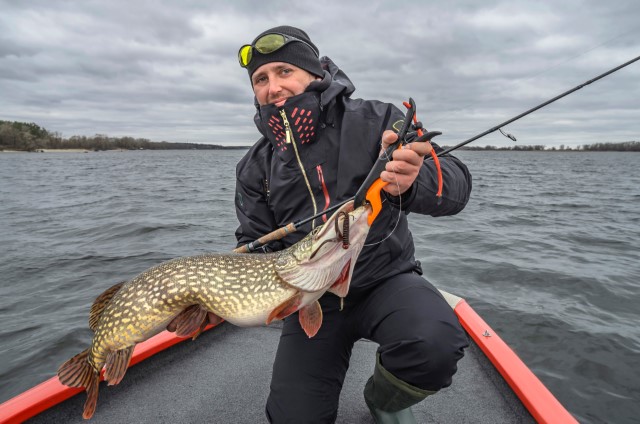
A fish grip has a handle and you clamp it onto the fish’s mouth. Look for fish grips that have strong locking mechanisms, so the fish can’t slip away.
If you prefer, you could use a landing net instead. A landing net is a type of fishing net, and it’s designed to secure the fish you’ve hooked.
RECOMMENDED: Rapala 9″ Floating Fish Gripper
Efficiency Essentials
I recommend having these items for the best success with kayak fishing.
An Appropriate Fishing Rod
A multi-use rod of medium length is best for kayak fishing. An inshore rod is usually appropriate. Heavier rods are generally needed for offshore angling.
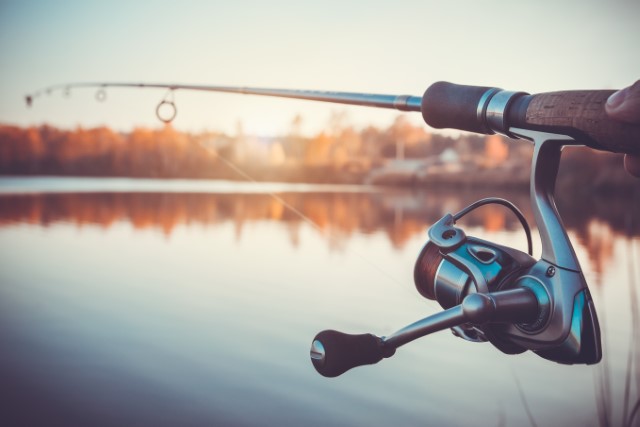
When it comes to kayak angling, you’ll have the most success with a fishing rod somewhere between 61/2 and 8 feet long. When deciding where to fall in that range, consider how important casting accuracy will be.
In situations where you’re in the open water, your casting distance becomes crucial. If these are the kinds of conditions you are working with, you should opt for an 8-foot-long rod.
RECOMMENDED: X5 Series Travel Fishing Rod & Case
Fishing Paddle
It’s crucial that you get the right kayak paddles – something that’s specifically designed for fishing. Take it from me, they need to be as lightweight as possible.
This will reduce the strain of having to paddle and fish at the same time.
Kayak angling paddlers frequently have a built-in hook retrieval notch or ruler. This will make it easier for you to preserve your lures.
Fishing paddles also usually weigh less than other kinds, meaning it will be easier for you to focus your energy on fishing. It’s best to get a kayak paddle that is a fiberglass blend, carbon fiber, or that features adjustable feathering.
Most kayakers find the best type of paddle for angling has a high angle. They should be broad, so they can push you through the water more efficiently.
You’ll probably need a longer-than-average paddle. This is because of how angling kayaks need to be quite wide, for better stability. If you’re tall, a long paddle will be even more necessary.
RECOMMENDED: Oceanbroad Carbon Fiber Fishing Kayak Paddle
Anchor System
You need to set up an anchor system for your kayak. This includes an anchor and a trolley.
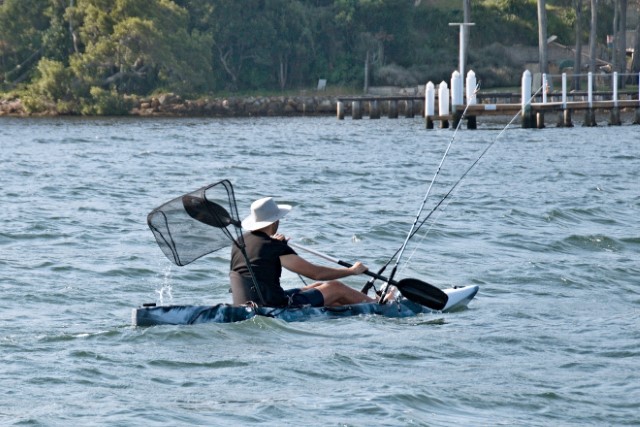
You’ll find anchoring much easier when you have this system set up. This means more time to fish!
The trolley will make it possible for you to get in the best possible position.
RECOMMENDED: Gradient Fitness Marine Anchor for Kayaks used with the Yusove Anchor Trolley Kit
Drift Chute (or Drift Sock)
Any chance you’ll fish in high wind conditions? You’ll definitely need a drift chute, which will let you deal with challenging elements.
You need a drift chute (also known as a drift sock) on hand so you can slow down your kayak when you need to. It becomes especially vital if you ever find yourself in choppy waters or higher than average winds.
Drift chutes tend to have a funnel shape. In some cases, they may look like tiny parachutes.
RECOMMENDED: Moocy Drift Sock
Convenience Essentials
Keeping things convenient is an important part of any recreational activity. I’ve provided a list of things to get for easier kayak fishing here.
Fish Finder
A fish finder is always a great addition to an angler’s store of equipment and tools. A fish finder gives you information about what is going on beneath the water.
It’s a fantastic way of showing you where fish are in school formation. You can use your fish finder to keep a log of what you see beneath the water on each trip.
You can use that information on future expeditions. Shop for a fish finder that is portable in size and has a colorful screen. A smart-phone enabled device is the best.
RECOMMENDED: Garmin Striker 4 GPS Fishfinder with Rechargeable Battery
Kayak Cart
You need a kayak cart in order to transport your kayak to the water without damaging it. It also makes your kayak much easier to move. If you don’t use one of these carts, you will damage the bottom of your vessel.
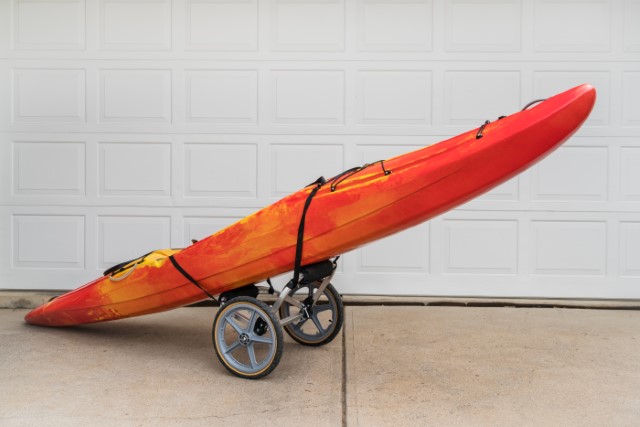
When shopping for a kayak cart, search for a folding or collapsible one. It’s much more convenient than the alternatives.
RECOMMENDED: Railblaza C-Tug Kayak Cart
Dry Bags
Remember to bring dry bags for extra clothing layers that you bring, as well as your personal electronics (such as your cell phone and camera). Don’t make the mistake of exposing these fishing kayak essentials to damage.
RECOMMENDED: Earth Pak Waterproof Dry Bag (roll-top)
Fishing Pliers
Make sure that the pliers you get are specifically made for fishing. Fishing pliers will make the process of switching your lures and tackle much easier and quicker.
The right kind of pliers should be made of aluminum or stainless steel.
RECOMMENDED: KastKing Cutthroat 7-inch Fishing Pliers
A Cooler
Ok, so maybe this isn’t an “essential” item for a fishing kayak, but in my view having a secure and accessible place to store some drinks and your lunch (or your catch) is a great thing to have on your fishing yak.
It’s one of those purchases you absolutely won’t regret making, and once you have a good one in your fishing yak setup you’ll never go back.
RECOMMENDED: Perception Splash Tankwell Cooler for Kayaks
The Right Kind of Kayak
Don’t have a kayak yet? I have some helpful guides you may want to check out – including a buying guide of the best fishing kayaks, and the best tandem fishing kayaks to help you choose your boat.
For now, I’ll briefly share what makes for a good fishing kayak.
Wider Kayaks are Best
Stability is important for anglers, for obvious reasons! Certain kinds of kayaks tend to offer better stability for fishing.
Most kayak anglers prefer wider kayaks, as they provide greater stability.
Whatever kayak you use for fishing, make sure it’s at least about 30 inches.
Choose the Right Length
But whatever you do, ensure it’s not too short.
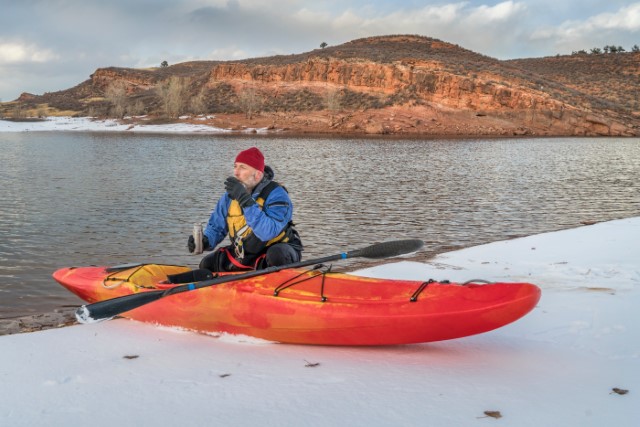
Your kayak may be the appropriate width but too short. When this happens, your watercraft will be way too slow-moving.
Yes, shorter kayaks shine for their maneuverability, but when you combine a short length with a wide width, you’re going to have problems.
But what is considered a short kayak and a long kayak? Well, we generally consider kayaks shorter than 11 feet to be shorter. A kayak exceeding 12 feet in length is a long kayak.
Where are you fishing? If you’re fishing on a river or a lake, you’ll probably want a relatively long kayak. A creek or pond, though, will probably call for something a little shorter.
Get a Sit-On-Top Kayak
If you’re planning on angling, choose a sit-on-top kayak. This design is better for kayaking.
If you’re choosing between a sit-inside kayak vs a sit on top kayak, then choose a sit-on-top (at least as your first fishing yak). They’re always trouble when fishing. If it flips, you’ll have more trouble getting your boat right way up. Water may get inside and that puts you at risk of capsizing.
Final Thoughts: Fishing Kayak Essentials
So, now you know all the essential items for fishing from your kayak. Remember to bring all the items I’ve listed here. Setting out on a kayak fishing trip without having all the necessary equipment will end up in a wasted day.
And if you’re new to kayaking, take a course with a certified instructor before you set off on the water.
.

